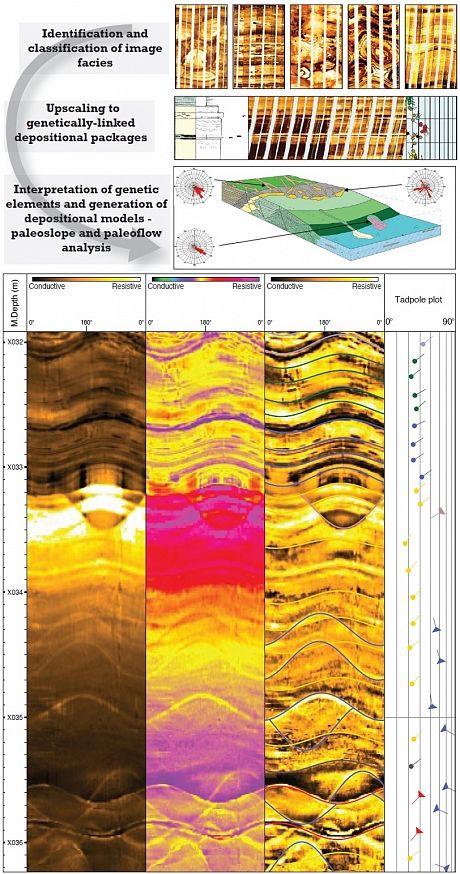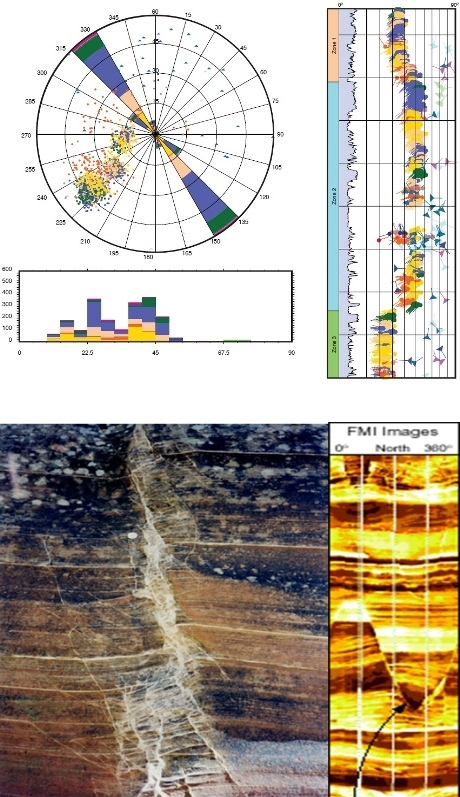
Course summary and outline
This interactive one day Borehole Image (BHI) awareness course is designed to provide an understanding of the advantages and limitations of current BHI devices, together with their applications and value to the Exploration-Appraisal-Production cycle. The course focuses on sedimentological and structural interpretation techniques, as well as methodologies for wider BHI integration with other data types. For these purposes, the course uses the Badley Ashton geologically-driven workflows and classification schemes for the different facets of the BHI interpretation.
Part A. Borehole Image data - acquisition, processing and QC
• Borehole Image and dip data principles
• Informed tool choice - comparison of the available BHI tools and their geological interpretability
• Recent developments (Quanta Geo/NGI, StarTrak)
• Data acquisition, processing and loading - the big points for discussions with Vendors
• Image display optimisation
• An overview of the QC of the image and dip data
• Introduction to petrophysical BHI applications
Part B. Workflows for an effective interpretation
• The work process and descriptive schemes
• Recognition of sedimentary, diagenetic and structural features
• Manual vs automatic dip interpretation
• Image facies identification and classification
• Structural dip evaluation and zonation
• Palaeoslope and palaeotransport analysis
• Fracture/fault analysis
• In situ stress determination
• The relative value of core-derived and BHI-derived datasets, and their effective 'marriage' (including CT core scans)
• Upscaling the BHI observations - depositional evolution and reservoir architecture interpretations
Part C. Application of the results - case studies
• Examples of deepwater projects integrating core, BHI, and CT scan data for reservoir architecture and fracture network determination
• Examples of BHI projects from other sedimentological environments (aeolian, fluvial, carbonate)
• Additional case studies from the client's own portfolio (assuming previous consultancy work by Badley Ashton)

Course Information
Instructors
Meriem Bertouche - Meriem is Badley Ashton's CEO and in-house BHI specialist. She is responsible for the quality control of all the BHI work that the Badley Ashton group undertake; she is also responsible for the training of Badley Ashton's staff in BHI interpretation and has particular experience in the Miocene and Oligocene turbidite systems of the Gulf of Mexico, Offshore West Africa and Offshore Malaysia. Meriem has presented this course several times in the past few years.
The course is suitable for geologists, geophysicists, petrophysicists, reservoir engineers and managers who wish to develop a better understanding of borehole image tools and their geological applications. No previous BHI experience is required.

This high resolution pdf provides a full overview of the course. (2.1mb)
If you would like more information on this, or any other courses, please e-mail training@badley-ashton.co.uk or call +44 (0) 1507 588353.
Feedback from this course
"Well organized, a lot of information was presented effectively". - Senior Geologist
"An excellent course for BHI. Highly recommended". - Geophysical Advisor
"The course material is excellent. It will be valuable when I apply learnings to future work and need reference examples". - Geologist
"Both instructors were very knowledgeable on the subject and communicated very effectively and answered questions well". - Geologist
"Very detailed course, with good handout material". - Geologist

Case Studies
The following case studies may be of interest:- The application of Borehole Imaging in appraising a Triassic (TAGI) fluvial reservoir,
- Sedimentology and depositional setting of the Asl and Hawara Members, October Field, Egypt
- High-frequency cyclicity in the Late Jurassic Arab Formation in a giant gas field, United Arab Emirates?
- New Insight on the Depositional Environment and Facies Atlas of Aptian in a Super Giant Carbonate Field in the Middle East

Articles
The following articles may be of interest:
- Badley Ashton delivers BHI training course to Hess
- Badley Ashton delivers Deepwater Reservoir Characterisation Course to Noble Energy
- Badley Ashton sponsor BSRG Ichnofabric Workshop
- Poster presentation and Core Workshops at the AAPG Siliciclastic Reservoirs of the Middle East GTW
- New SEM-cathodoluminescence detector installed

Publications
The following publications may be of interest:
- A sedimentological application of ultrasonic borehole images in complex lithologies: the Lower Kimmeridge Clay Formation, Magnus Field, UKCS
- Fault and fracture prediction from coherence data analysis, a case study - The Magnus Field, UKCS
- Integrated Reservoir Characterization in Pursuit of a Heavy Oil Giant in the Arctic
- Increase Productive Life and Add to In-Place Oil in Mature Reservoirs with Integrated Studies: Zubair Reservoir in Kuwait
- High-resolution aquifer characterization using seismic cross-hole tomography: An evaluation experiment in a gravel delta

